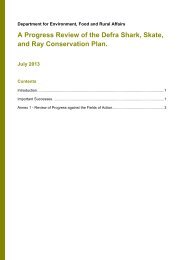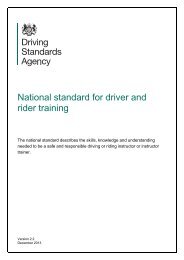Decontamination in primary care dental practices - Gov.uk
Decontamination in primary care dental practices - Gov.uk
Decontamination in primary care dental practices - Gov.uk
Create successful ePaper yourself
Turn your PDF publications into a flip-book with our unique Google optimized e-Paper software.
16 Approach and protocol for manual clean<strong>in</strong>g16 Approach and protocol for manual clean<strong>in</strong>gNoteThe use of manual clean<strong>in</strong>g presents particularproblems. Because the process is not automatic, itis not possible to fully validate the process. Manualclean<strong>in</strong>g is thus not the preferred method of clean<strong>in</strong>g.Where possible, manual clean<strong>in</strong>g should be replacedwith automated clean<strong>in</strong>g. However, where manualclean<strong>in</strong>g is necessary (for example, as advised by themanufacturer) and where the practice is operat<strong>in</strong>gunder the essential quality requirements, the criticalparameters should be controlled as much as possible toreduce the variability <strong>in</strong> clean<strong>in</strong>g performance. Thefollow<strong>in</strong>g advice aims to enable this control as muchas possible.16.1 A dirty-to-clean workflow should be ma<strong>in</strong>ta<strong>in</strong>edthroughout the clean<strong>in</strong>g procedure. Two s<strong>in</strong>ksor bowls should be provided – one for manualclean<strong>in</strong>g and one for r<strong>in</strong>s<strong>in</strong>g. In addition, separatesett<strong>in</strong>g-down areas should be used for dirty<strong>in</strong>struments and for clean <strong>in</strong>struments.16.2 If lack of space means that a sett<strong>in</strong>g-down area hasto be used for both dirty and clean <strong>in</strong>struments atdifferent times dur<strong>in</strong>g the decontam<strong>in</strong>ation process,the surface should be thoroughly cleaned betweenstages us<strong>in</strong>g a water–detergent solution to m<strong>in</strong>imisethe risks of cross-contam<strong>in</strong>ation.16.3 Always use detergents specifically formulated formanual clean<strong>in</strong>g of <strong>in</strong>struments.ImportantDo not use chlorhexid<strong>in</strong>e handscrub (for exampleHibiscrub), wash<strong>in</strong>g-up liquid, clean<strong>in</strong>g creams orsoap. Chlorhexid<strong>in</strong>e <strong>in</strong> particular makes prote<strong>in</strong>s stickto steel.Clean<strong>in</strong>g procedure for <strong>dental</strong><strong>in</strong>strumentsa. Measure the volume of water and detergent toachieve the concentration specified by thedetergent manufacturer. A l<strong>in</strong>e pa<strong>in</strong>ted on thes<strong>in</strong>k is useful to <strong>in</strong>dicate the required volume ofwater. The detergent should be designed for themanual clean<strong>in</strong>g of <strong>dental</strong> <strong>in</strong>struments.b. Us<strong>in</strong>g a mercury-free thermometer, monitorthe temperature of the water throughout theclean<strong>in</strong>g procedure to ensure the temperatureof the water is 45oC or lower (a highertemperature will coagulate prote<strong>in</strong> and <strong>in</strong>hibitits removal). The temperature of the fluidshould be as recommended by the detergentmanufacturer.c. Where manufacturers’ <strong>in</strong>structions permit, fullysubmerge items to be cleaned <strong>in</strong> the detergentsolution.d. Scrub <strong>in</strong>struments us<strong>in</strong>g long-handled brusheswith soft plastic bristles. To m<strong>in</strong>imise aerosolrisk, fully immerse the <strong>in</strong>struments <strong>in</strong> thesolution and keep under water dur<strong>in</strong>g theclean<strong>in</strong>g process.e. Follow<strong>in</strong>g clean<strong>in</strong>g, dra<strong>in</strong> the water, avoid<strong>in</strong>gsplash<strong>in</strong>g. If the water is heavily soiled, repeatthe clean<strong>in</strong>g procedure.f. Brushes should be s<strong>in</strong>gle use. Where they arereusable, after each use, the brushes should bewashed <strong>in</strong> hot water us<strong>in</strong>g the manufacturer’srecommended detergent, <strong>in</strong> order to removevisible soil, and be stored dry and head up.Or dispose of brushes if they are s<strong>in</strong>gle-use.Reusable brushes should be replaced at themanufacturer’s recommended <strong>in</strong>terval or morefrequently if the brush is seen to havesignificantly deteriorated.g. Carry out a f<strong>in</strong>al r<strong>in</strong>se <strong>in</strong> the clean s<strong>in</strong>k us<strong>in</strong>gsatisfactory potable water (see paragraphs 3.14,and 17.8–17.10), or RO water or distilled wateronly.h. After r<strong>in</strong>s<strong>in</strong>g, dra<strong>in</strong> and dry if <strong>in</strong>struments are tobe wrapped.63
















